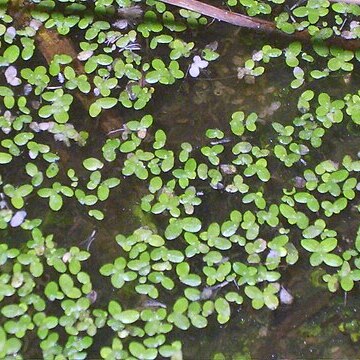Roots to 3.5 cm, tip usually sharp pointed; sheath narrowly winged at base (wing 2--3 times as long as wide). Stipes white, small, often decaying. Fronds floating, 1 or 2--few, coherent in groups, ovate-obovate, flat, 1--4 mm, 1--1.7 times as long as wide, margins entire; veins 3, greatest distance between lateral veins near or distal to middle; 1 distinct papilla near apex on upper surface, 2--3 very distinct papillae above node; anthocyanin absent, no reddish color; air spaces much shorter than 0.3 mm; distinct turions absent. Flowers: ovaries 1-ovulate, utricular scale open on 1 side. Fruits 0.7--1 mm, not winged. Seeds with 35--70 indistinct ribs, staying within fruit wall after ripening. 2n = 40 (U), 42 (G).
Thallus ± convex on both sides, with a prominent papilla at node and apex above, and usually with smaller papillae along the midline, obliquely obovate, asymmetrical and ± falcate, 1–2.5 mm, commonly 1–2 times as long as wide, solitary or up to 5 together, not anthocyanic, with 1–3 obscure nerves or nerveless; root-sheath winged at base (unique in the genus); spathe reduced, open; fr asymmetrical, with a persistent lateral style; seed solitary, ovoid, strongly ribbed; 2n=40. Nearly cosmop., and found in most of our range. (L. trinervis)
Thallus free-floating, pale green, ovate, variable in size, 1.5–4 mm. long, 0.7–2.5 mm. wide, asymmetrical, upper surface with or without an apical papilla and 1 or more along the midline, obscurely 3-nerved.. Daughter thallus very shortly stipitate, several individuals adhering closely.. Root solitary; sheath winged below the thallus; root-cap acute.. Flowering cavity lateral; spathe open.. Staminate flowers 2; anthers 2-thecous.. Pistillate flower 1; style concave.. Fruit ribbed, 1-seeded.. Fig. 1/4, p. 3.
A plant that floats in water.


